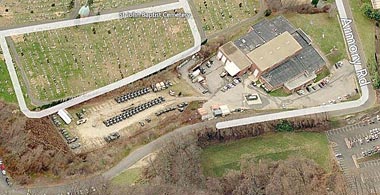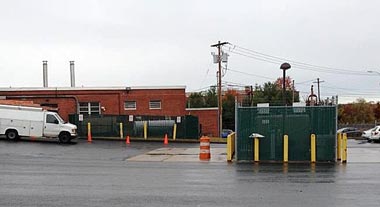Project Years: 2013-2015
RCRA / CERCLA Cleanup Process
FSE conducted a RI/FS at the Stratford Armory and Field Maintenance Shop, an active CT Army National Guard (CTARNG) facility located in Stratford, CT. The RI/FS followed the CERCLA process and evaluated potential impacts from the following primary sources:
- former diesel, gasoline and fuel oil UST’s and AST’s
- current diesel AST
- vehicle maintenance
- vehicle storage and
- an active wash rack area
PCB’s from window caulking were evaluated and remediated separately by the CTARNG and were not in the scope of work.
Design and Implementation of Remediation Strategies
FSE completed the following tasks: developed work plans; conducted a field membrane interface probe (MIP) study; completed a soil sampling and analysis study using direct push technology (DPT) drilling techniques; advanced soil borings and installed overburden and bedrock groundwater monitoring wells; performed soil and groundwater sampling; performed site characterization; and completed a Remedial Investigation and Feasibility Study.
Overall, no groundwater RCRA 8 Metals, SVOC or VOC concentrations were reported above the listed screening levels. Low levels of total metals were detected but did not warrant further evaluation by TCLP or SPLP analytical methods.
The MIP and DPT soil investigations did not identify significant site-wide soil impacts. Existing soil COPC concentrations that were detected at low concentrations at two locations (DPT-13 and DPT-18) are not likely to result in future groundwater impacts.
 Based on the RI results only one RAO was identified for the Site. The RAO identified was for soil media within the military vehicle parking area. A detailed analysis of alternatives was completed to select the appropriate remedy for the site. Excavation and Off-Site Disposal is the most practicable permanent solution for the site.
Based on the RI results only one RAO was identified for the Site. The RAO identified was for soil media within the military vehicle parking area. A detailed analysis of alternatives was completed to select the appropriate remedy for the site. Excavation and Off-Site Disposal is the most practicable permanent solution for the site.
Groundwater Investigation and Modeling / Soil and Sediment Investigation
The real-time MIP and EC data were evaluated in the field to determine additional survey locations and to establish soil sampling intervals and monitoring well screen intervals. The soil sampling program consisted of 25 MIP probes, 38 DPT soil samples and 8 MW split spoon samples. The MIP’s, DPT’s and MW’s were each drilled to refusal on assumed bedrock. The depth to bedrock at the site varied from 0 feet bgs (exposed bedrock) to approximately 27 feet bgs.
Groundwater was not encountered within the vehicle parking area where the shallow depth to bedrock varied from 0 to 8 feet bgs. Groundwater was observed to fluctuate seasonally across the overburden/bedrock interface.
FSE performed four quarterly groundwater gauging and sampling events to evaluate seasonal fluctuations in groundwater elevation and chemistry. The quarterly groundwater investigations included low flow sampling.


Environmental Chemistry, Data Collection, Management and Interpretation
A total of forty six (46) soil samples (38 DPT soils samples and 8 MW soil samples) were submitted for laboratory analysis for RCRA 8 Metals, SVOC’s and VOC’s. Several of the RCRA 8 Metals, and in particular for this site, arsenic, are naturally occurring inorganic constituents most of which are expected to be present naturally in the environmental media tested during the RI. No VOC’s were reported above the listed screening levels. Groundwater samples were analyzed for RCRA 8 Metals, SVOC’s and VOC’s.
Data validation included the review of analytical procedures, quality control (QC), calibration, data reduction, and completeness of the laboratory data package as specified in the RI/FS SAP and QAPP. Laboratory Data Consultants Inc. (LDC) Automated Data Review (ADR) software was used to evaluate Sample Delivery Groups (SDGs).
The ADR electronic Quality Assurance Project Plan (eQAPP) incorporates laboratory quality control criteria, and was used to validate the data. The data from each SDG was processed through the ADR processor and qualification and outlier reports were produced. A review of the qualifiers added by the ADR program was performed on randomly selected sample results in order to confirm identified outliers and identify any omissions from the validation performed by ADR.NET.
Human Health and Ecological Risk Assessment / Vapor Intrusion Investigation and Mitigation
A baseline human health risk assessment (BHHRA) was conducted. The BHHRA was completed in accordance with EPA’s guidance (RAGS: Part D), with consideration of CTDEEP’s Remediation Standard Regulations (RSRs). No potential hazard was identified for Site groundwater, surface water, and sediment. Therefore, these media were not quantitatively evaluated in the BHHRA.
Environmental Investigation and Cleanup with Local, State and Federal Regulatory Compliance
In order to reflect potential future ownership of the residentially-zoned Site, the RI/FS assessment and inferences have incorporated the CTDEEP Property Transfer Program (PTP) regulations under the Connecticut General Statute (CGS) 22a-134a, and Voluntary Remediation Program (VRP) regulations under CGS Section 22a-133x.
